MENU
The Electronic Scholarly Publishing Project: Providing access to classic scientific papers and other scholarly materials, since 1993. More About: ESP | OUR CONTENT | THIS WEBSITE | WHAT'S NEW | WHAT'S HOT
Comparative Timelines
The ESP Timeline (one of the site's most popular features) has been completely updated to allow the user to select (using the timeline controls above each column) different topics for the left and right sides of the display.
Select:
New Left Column
New Left Column
Dates
Decade
New Right Column
New Right Column
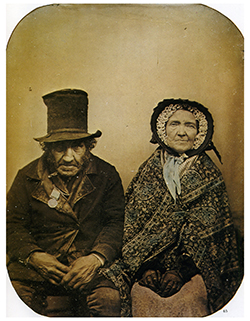 "A Veteran with his Wife", taken by an anonymous photographer, shows a British veteran of the Napoleonic era Peninsular Wars. It is a hand-tinted ambrotype using the set collodion positive process, made circa 1860.
"A Veteran with his Wife", taken by an anonymous photographer, shows a British veteran of the Napoleonic era Peninsular Wars. It is a hand-tinted ambrotype using the set collodion positive process, made circa 1860.
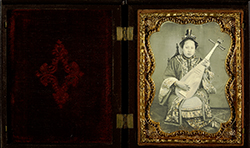 Daguerreotype by Unknown Photographer: Portrait of a Woman with a Mandolin. Collection of the J. Paul Getty Museum.
Daguerreotype by Unknown Photographer: Portrait of a Woman with a Mandolin. Collection of the J. Paul Getty Museum.
1860
(no entry for this year)
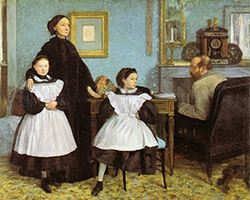 Painting by Edgar Degas: The Bellelli Family, also known as Family Portrait, is housed in the Musée d'Orsay. A masterwork of Degas' youth, the painting is a portrait of his aunt, her husband, and their two young daughters. While finishing his artistic training in Italy, Degas drew and painted his aunt Laura, her husband the baron Gennaro Bellelli, and their daughters Giulia and Giovanna. Although it is not known for certain when or where Degas executed the painting, it is believed that he utilized studies done in Italy to complete the work after his return to Paris. Laura, his father's sister, is depicted in a dress which symbolizes mourning for her father, who had recently died and appears in the framed portrait behind her. Laura Bellelli's countenance is dignified and austere, her gesture connected with those of her daughters. Her husband, by contrast, appears to be separated from his family. His association with business and the outside world is implied by his position at his desk. Giulia holds a livelier pose than that of her sister Giovanna, whose restraint appears to underscore the familial tensions.
Painting by Edgar Degas: The Bellelli Family, also known as Family Portrait, is housed in the Musée d'Orsay. A masterwork of Degas' youth, the painting is a portrait of his aunt, her husband, and their two young daughters. While finishing his artistic training in Italy, Degas drew and painted his aunt Laura, her husband the baron Gennaro Bellelli, and their daughters Giulia and Giovanna. Although it is not known for certain when or where Degas executed the painting, it is believed that he utilized studies done in Italy to complete the work after his return to Paris. Laura, his father's sister, is depicted in a dress which symbolizes mourning for her father, who had recently died and appears in the framed portrait behind her. Laura Bellelli's countenance is dignified and austere, her gesture connected with those of her daughters. Her husband, by contrast, appears to be separated from his family. His association with business and the outside world is implied by his position at his desk. Giulia holds a livelier pose than that of her sister Giovanna, whose restraint appears to underscore the familial tensions.
1861
(no entry for this year)
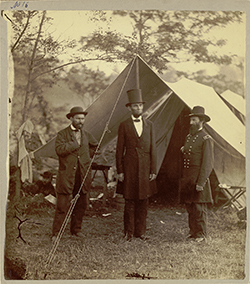 Photograph by Alexander Gardner: President Abraham Lincoln, Headquarters, Army of the Potomac, near Antietam, an albumen silver print. Allan Pinkerton stands to Lincoln's right, General John A. McClernand to Lincoln's left.
Photograph by Alexander Gardner: President Abraham Lincoln, Headquarters, Army of the Potomac, near Antietam, an albumen silver print. Allan Pinkerton stands to Lincoln's right, General John A. McClernand to Lincoln's left.
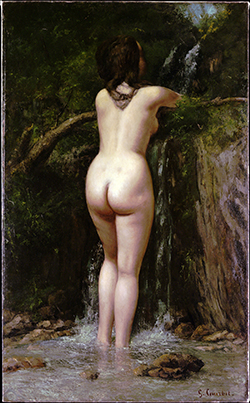 Painting by Gustave Courbet: The Source shows a nude in an unflinchingly naturalistic style and is devoid of the trappings of academic allegory to which the painting's title alludes. Courbet is thought to have intended it as a response to Ingres's own La Source (1856, Musée d Orsay, Paris), which was exhibited at the Galerie Martinet, Paris, in 1861. The picture by Ingres depicts an idealized nude holding a jar from which water pours, an allusion to a spring or river source, and symbolizing poetic inspiration.
Painting by Gustave Courbet: The Source shows a nude in an unflinchingly naturalistic style and is devoid of the trappings of academic allegory to which the painting's title alludes. Courbet is thought to have intended it as a response to Ingres's own La Source (1856, Musée d Orsay, Paris), which was exhibited at the Galerie Martinet, Paris, in 1861. The picture by Ingres depicts an idealized nude holding a jar from which water pours, an allusion to a spring or river source, and symbolizing poetic inspiration.
1862
(no entry for this year)
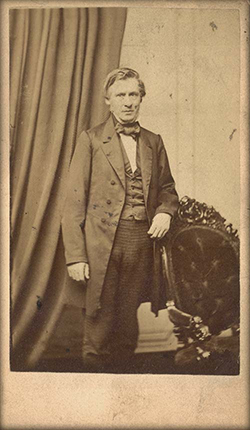 Photograph by John Adams Whipple: Asa Gray, an albumen print. Gray was considered the most important American botanist of the 19th century. His Darwiniana was considered an important explanation of how religion and science were not necessarily mutually exclusive. As a professor of botany at Harvard University for several decades, Gray regularly visited, and corresponded with, many of the leading natural scientists of the era, including Charles Darwin, who held great regard for him. Gray made several trips to Europe to collaborate with leading European scientists of the era, as well as trips to the southern and western United States. He also built an extensive network of specimen collectors.
Photograph by John Adams Whipple: Asa Gray, an albumen print. Gray was considered the most important American botanist of the 19th century. His Darwiniana was considered an important explanation of how religion and science were not necessarily mutually exclusive. As a professor of botany at Harvard University for several decades, Gray regularly visited, and corresponded with, many of the leading natural scientists of the era, including Charles Darwin, who held great regard for him. Gray made several trips to Europe to collaborate with leading European scientists of the era, as well as trips to the southern and western United States. He also built an extensive network of specimen collectors.
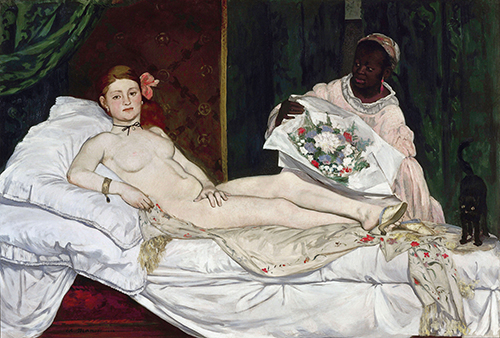 Painting by Édouard Manet: Olympia shocked the art world with its style (strong brush strokes, considered childish and unskilled) and its subject matter, a nude white woman ("Olympia"), presumably a courtesan, lying on a bed being brought flowers by a black servant. When hung in the Salon of Paris in 1865, it was met with jeers, laughter, criticism, and disdain, and was attacked by the public, the critics, the newspapers. Guards were stationed to protect it, until it was moved to a spot high above a doorway, out of reach.
Painting by Édouard Manet: Olympia shocked the art world with its style (strong brush strokes, considered childish and unskilled) and its subject matter, a nude white woman ("Olympia"), presumably a courtesan, lying on a bed being brought flowers by a black servant. When hung in the Salon of Paris in 1865, it was met with jeers, laughter, criticism, and disdain, and was attacked by the public, the critics, the newspapers. Guards were stationed to protect it, until it was moved to a spot high above a doorway, out of reach.
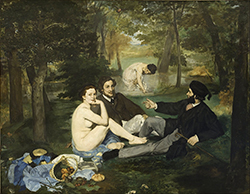 Painting by Édouard Manet: Le Déjeuner sur l'herbe (English: The Luncheon on the Grass) is a large oil on canvas painting depicting a female nude and a scantily dressed female bather on a picnic with two fully dressed men in a rural setting. Rejected by the Salon jury of 1863, Manet seized the opportunity to exhibit this and two other paintings in the 1863 Salon des Refusés where the painting sparked public notoriety and controversy. The piece is now in the Musée d'Orsay in Paris. A smaller, earlier version can be seen at the Courtauld Gallery, London. The painting features a nude woman casually lunching with two fully dressed men. Her body is starkly lit and she stares directly at the viewer. The two men, dressed as young dandies, seem to be engaged in conversation, ignoring the woman. In front of them, the woman's clothes, a basket of fruit, and a round loaf of bread are displayed, as in a still life. In the background, a lightly clad woman bathes in a stream. Too large in comparison with the figures in the foreground, she seems to float above them. The roughly painted background lacks depth — giving the viewer the impression that the scene is not taking place outdoors, but in a studio. This impression is reinforced by the use of broad "studio" light, which casts almost no shadows. The man on the right wears a flat hat with a tassel, of a kind normally worn indoors. Despite the mundane subject, Manet deliberately chose a large canvas size, measuring 81.9 by 104.1 inches, normally reserved for historical, religious, and mythological subjects. The style of the painting breaks with the academic traditions of the time. He did not try to hide the brush strokes; the painting even looks unfinished in some parts of the scene.
Painting by Édouard Manet: Le Déjeuner sur l'herbe (English: The Luncheon on the Grass) is a large oil on canvas painting depicting a female nude and a scantily dressed female bather on a picnic with two fully dressed men in a rural setting. Rejected by the Salon jury of 1863, Manet seized the opportunity to exhibit this and two other paintings in the 1863 Salon des Refusés where the painting sparked public notoriety and controversy. The piece is now in the Musée d'Orsay in Paris. A smaller, earlier version can be seen at the Courtauld Gallery, London. The painting features a nude woman casually lunching with two fully dressed men. Her body is starkly lit and she stares directly at the viewer. The two men, dressed as young dandies, seem to be engaged in conversation, ignoring the woman. In front of them, the woman's clothes, a basket of fruit, and a round loaf of bread are displayed, as in a still life. In the background, a lightly clad woman bathes in a stream. Too large in comparison with the figures in the foreground, she seems to float above them. The roughly painted background lacks depth — giving the viewer the impression that the scene is not taking place outdoors, but in a studio. This impression is reinforced by the use of broad "studio" light, which casts almost no shadows. The man on the right wears a flat hat with a tassel, of a kind normally worn indoors. Despite the mundane subject, Manet deliberately chose a large canvas size, measuring 81.9 by 104.1 inches, normally reserved for historical, religious, and mythological subjects. The style of the painting breaks with the academic traditions of the time. He did not try to hide the brush strokes; the painting even looks unfinished in some parts of the scene.
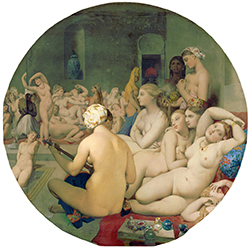 Painting by Jean Auguste Dominique Ingres: The Turkish Bath (Le Bain Turc) depicts a group of nude women in the bath of a harem, and is painted in a highly erotic style that evokes both the near east and earlier western styles associated with mythological subject matter. Painted on canvas laid down on wood, it measures 108 x 108 cm. The work is signed and dated 1862, when Ingres was around 82 years old, and was completed in 1863. In that year Ingres altered the painting's original rectangular format, and cut the painting to its present tondo form. Photographs of the painting in its original format survive. It seems based on an April 1717 written description of a Turkish harem by Lady Mary Montagu, where she mentions having viewed some two hundred nude women. The painting develops and elaborates a number of motifs Ingres had explored in earlier paintings, in particular his 1808 The Valpinçon Bather and Grande Odalisque of 1814. Its erotic content did not provoke a scandal, since for much its existence it has remained in private collections. It is now in the Louvre, Paris.
Painting by Jean Auguste Dominique Ingres: The Turkish Bath (Le Bain Turc) depicts a group of nude women in the bath of a harem, and is painted in a highly erotic style that evokes both the near east and earlier western styles associated with mythological subject matter. Painted on canvas laid down on wood, it measures 108 x 108 cm. The work is signed and dated 1862, when Ingres was around 82 years old, and was completed in 1863. In that year Ingres altered the painting's original rectangular format, and cut the painting to its present tondo form. Photographs of the painting in its original format survive. It seems based on an April 1717 written description of a Turkish harem by Lady Mary Montagu, where she mentions having viewed some two hundred nude women. The painting develops and elaborates a number of motifs Ingres had explored in earlier paintings, in particular his 1808 The Valpinçon Bather and Grande Odalisque of 1814. Its erotic content did not provoke a scandal, since for much its existence it has remained in private collections. It is now in the Louvre, Paris.
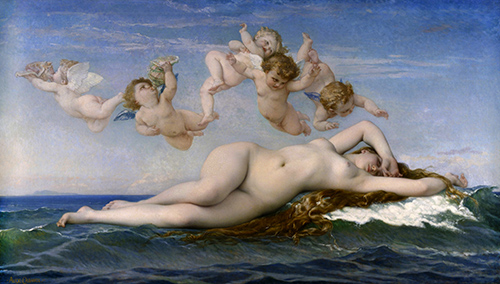 Painting by Alexandre Cabanel: The Birth of Venus, now in the Musée d'Orsay in Paris. A second and smaller version (85 × 135.9 cm) from ca. 1864 is in Dahesh Museum of Art. A third (106 × 182.6 cm)[2] version dates from 1875; it is in the Metropolitan Museum of Art in New York City. Shown to great success at the Paris Salon of 1863, The Birth of Venus was immediately purchased by Napoleon III for his own personal collection. That same year Cabanel was made a professor of the Ecole des Beaux-Arts. Cabanel's combination of sensual and classical imagery appealed to the higher levels of society. Art historian and curator Robert Rosenblum wrote of Cabanel's The Birth of Venus that "This Venus hovers somewhere between an ancient deity and a modern dream"; he described "the ambiguity of her eyes, that seem to be closed but that a close look reveals that she is awake ... A nude who could be asleep or awake is specially formidable for a male viewer."
Painting by Alexandre Cabanel: The Birth of Venus, now in the Musée d'Orsay in Paris. A second and smaller version (85 × 135.9 cm) from ca. 1864 is in Dahesh Museum of Art. A third (106 × 182.6 cm)[2] version dates from 1875; it is in the Metropolitan Museum of Art in New York City. Shown to great success at the Paris Salon of 1863, The Birth of Venus was immediately purchased by Napoleon III for his own personal collection. That same year Cabanel was made a professor of the Ecole des Beaux-Arts. Cabanel's combination of sensual and classical imagery appealed to the higher levels of society. Art historian and curator Robert Rosenblum wrote of Cabanel's The Birth of Venus that "This Venus hovers somewhere between an ancient deity and a modern dream"; he described "the ambiguity of her eyes, that seem to be closed but that a close look reveals that she is awake ... A nude who could be asleep or awake is specially formidable for a male viewer."
1863
(no entry for this year)
(no entry for this year)
1864
 James Clerk Maxwell's A dynamical theory of the electromagnetic field is the first of his publications to use Michael Faraday's concept of a field as the basis of the mathematical treatment of electricity and magnetism. It introduces Maxwell's equations to describe electromagnetism.
James Clerk Maxwell's A dynamical theory of the electromagnetic field is the first of his publications to use Michael Faraday's concept of a field as the basis of the mathematical treatment of electricity and magnetism. It introduces Maxwell's equations to describe electromagnetism.
 Alice's Adventures in Wonderland (commonly shortened to Alice in Wonderland) first published. The novel was written by English author Charles Lutwidge Dodgson under the pseudonym Lewis Carroll.
Alice's Adventures in Wonderland (commonly shortened to Alice in Wonderland) first published. The novel was written by English author Charles Lutwidge Dodgson under the pseudonym Lewis Carroll.
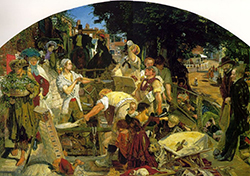 Painting by Ford Madox Brown: Work is generally considered to be his most important achievement. It exists in two versions. The painting attempts to portray, both literally and analytically, the totality of the Victorian social system and the transition from a rural to an urban economy. Brown began the painting in 1852 and completed it in 1865, when he set up a special exhibition to show it along with several of his other works. He wrote a detailed catalogue explaining the significance of the picture. The picture depicts a group of so-called "navvies" digging up the road to build an underground tunnel. It is typically assumed that this was part of the extensions of London's sewerage system, which were being undertaken to deal with the threat of typhus and cholera. The workers are in the centre of the painting. On either side of them are individuals who are either unemployed or represent the leisured classes. Behind the workers are two wealthy figures on horseback, whose progress along the road has been halted by the excavations. The painting also portrays an election campaign, evidenced by posters and people carrying sandwich boards with the name of the candidate "Bobus". A poster also draws attention to the potential presence of a burglar. The setting is an accurate depiction of The Mount on Heath Street in Hampstead, London, where a side road rises up above the main road and runs alongside it. Brown made a detailed study of the location in 1852.
Painting by Ford Madox Brown: Work is generally considered to be his most important achievement. It exists in two versions. The painting attempts to portray, both literally and analytically, the totality of the Victorian social system and the transition from a rural to an urban economy. Brown began the painting in 1852 and completed it in 1865, when he set up a special exhibition to show it along with several of his other works. He wrote a detailed catalogue explaining the significance of the picture. The picture depicts a group of so-called "navvies" digging up the road to build an underground tunnel. It is typically assumed that this was part of the extensions of London's sewerage system, which were being undertaken to deal with the threat of typhus and cholera. The workers are in the centre of the painting. On either side of them are individuals who are either unemployed or represent the leisured classes. Behind the workers are two wealthy figures on horseback, whose progress along the road has been halted by the excavations. The painting also portrays an election campaign, evidenced by posters and people carrying sandwich boards with the name of the candidate "Bobus". A poster also draws attention to the potential presence of a burglar. The setting is an accurate depiction of The Mount on Heath Street in Hampstead, London, where a side road rises up above the main road and runs alongside it. Brown made a detailed study of the location in 1852.
1865
 Rudolf Clausius invents the term ENTROPY to describe the degradation of energy in the closed system.
Rudolf Clausius invents the term ENTROPY to describe the degradation of energy in the closed system.
 Blue Danube Waltz Presented Johann Strauss the younger first presents his Blue Danube Waltz, which later became one of the most popular and familiar works of European music.
Blue Danube Waltz Presented Johann Strauss the younger first presents his Blue Danube Waltz, which later became one of the most popular and familiar works of European music.
1866
(no entry for this year)
(no entry for this year)
1867
(no entry for this year)
 Louisa May Alcott publishes Little Women.
Louisa May Alcott publishes Little Women.
1868
(no entry for this year)
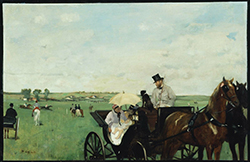 Painting by : At the Races in the Countryside. This painting was one of the first works that Degas sold (in 1872) to Paul Durand-Ruel, the dealer who became the early champion of the Impressionists. It is not only a landscape but also a scene from everyday life and — most of all — a family portrait. The driver of the carriage is Degas's friend Paul Valpin on, who is shown with his wife, a wet nurse, and in the nurse's lap, the couple's son, Henri.
Painting by : At the Races in the Countryside. This painting was one of the first works that Degas sold (in 1872) to Paul Durand-Ruel, the dealer who became the early champion of the Impressionists. It is not only a landscape but also a scene from everyday life and — most of all — a family portrait. The driver of the carriage is Degas's friend Paul Valpin on, who is shown with his wife, a wet nurse, and in the nurse's lap, the couple's son, Henri.
1869
(no entry for this year)
ESP Quick Facts
ESP Origins
In the early 1990's, Robert Robbins was a faculty member at Johns Hopkins, where he directed the informatics core of GDB — the human gene-mapping database of the international human genome project. To share papers with colleagues around the world, he set up a small paper-sharing section on his personal web page. This small project evolved into The Electronic Scholarly Publishing Project.
ESP Support
In 1995, Robbins became the VP/IT of the Fred Hutchinson Cancer Research Center in Seattle, WA. Soon after arriving in Seattle, Robbins secured funding, through the ELSI component of the US Human Genome Project, to create the original ESP.ORG web site, with the formal goal of providing free, world-wide access to the literature of classical genetics.
ESP Rationale
Although the methods of molecular biology can seem almost magical to the uninitiated, the original techniques of classical genetics are readily appreciated by one and all: cross individuals that differ in some inherited trait, collect all of the progeny, score their attributes, and propose mechanisms to explain the patterns of inheritance observed.
ESP Goal
In reading the early works of classical genetics, one is drawn, almost inexorably, into ever more complex models, until molecular explanations begin to seem both necessary and natural. At that point, the tools for understanding genome research are at hand. Assisting readers reach this point was the original goal of The Electronic Scholarly Publishing Project.
ESP Usage
Usage of the site grew rapidly and has remained high. Faculty began to use the site for their assigned readings. Other on-line publishers, ranging from The New York Times to Nature referenced ESP materials in their own publications. Nobel laureates (e.g., Joshua Lederberg) regularly used the site and even wrote to suggest changes and improvements.
ESP Content
When the site began, no journals were making their early content available in digital format. As a result, ESP was obliged to digitize classic literature before it could be made available. For many important papers — such as Mendel's original paper or the first genetic map — ESP had to produce entirely new typeset versions of the works, if they were to be available in a high-quality format.
ESP Help
Early support from the DOE component of the Human Genome Project was critically important for getting the ESP project on a firm foundation. Since that funding ended (nearly 20 years ago), the project has been operated as a purely volunteer effort. Anyone wishing to assist in these efforts should send an email to Robbins.
ESP Plans
With the development of methods for adding typeset side notes to PDF files, the ESP project now plans to add annotated versions of some classical papers to its holdings. We also plan to add new reference and pedagogical material. We have already started providing regularly updated, comprehensive bibliographies to the ESP.ORG site.
ESP Picks from Around the Web (updated 06 MAR 2017 )
Old Science

Weird Science

Treating Disease with Fecal Transplantation
Fossils of miniature humans (hobbits) discovered in Indonesia

Dinosaur tail, complete with feathers, found preserved in amber.
Astronomy

Mysterious fast radio burst (FRB) detected in the distant universe.